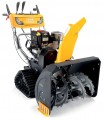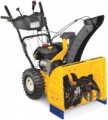Working width
The width of the strip of snow that the snow blower can clear in one pass. The larger the capture width, the fewer passes will be required to process the site, which is especially important on large areas. On the other hand, for processing small spaces, clearing individual paths, etc. significant width is not required (moreover, a “narrow” snow blower will pass more easily in a hard-to-reach place). The larger the capture width, the more powerful the engine, usually, ceteris paribus.
The most compact modern snow blowers have a working width of
less than 50 cm, these are mainly electric models of low power, although gasoline units are also found. A width of
50 – 60 cm can be called relatively small,
60 – 70 cm — medium, and in the largest models this figure
exceeds 70 cm.
Snow height
The maximum thickness of the snow layer that the snow blower removes in one pass. If you plan to regularly remove snow as it falls in a small area (for example, in the courtyard of your own private house), a grip height of up to 20 cm will be enough. If the opportunity to remove snow is rare (for example, in a country house where you visit only on weekends), you should pay attention to more powerful models with a height of about 50 cm.
Min. throw distance
The shortest distance that the snow blower can throw the collected snow.
The minimum range is indicated only for models with adjustable throw distance (see above). The meaning of this parameter is that in fact, long-range snow casting is not always desirable. For example, when clearing a path in the yard of a private house, snow often has to be poured literally next to the path, a little further — and it will fly onto the windows and walls of the house.
Note that the ejection range is a rather conditional value, because. snow (especially loose, freshly fallen snow) tends to dissipate in flight.
Auger / brush diameter
The diameter of the working tool of the snow blower. Other things being equal (primarily engine power), a smaller diameter auger gives more force during rotation, and a larger diameter auger allows you to process more snow in the same time. Therefore, units with large augers can be recommended primarily for working with large volumes of relatively soft snow, and with small ones — for dense packed cover and crust.
Movement
—
On wheels. The most common option among modern snow blowers. Wheeled units turn out to be quite light and manoeuvrable, and problems with cross-country ability can only arise on very rough terrain.
—
On caterpillars. Tracks provide less ground pressure than wheels and a larger contact area. This significantly increases the cross-country ability and allows you to effectively overcome pits, bumps, steep climbs and other difficult places that are “too tough” for wheeled units. On the other hand, tracks are noticeably more complex and expensive than wheels, they can only be used in self-propelled models, and all the advantages become noticeable only on very rough terrain. Therefore, it makes sense to pay attention to caterpillar snow blowers only if maximum cross-country ability is fundamentally important to you.
Selectable locking differential
The ability to
unlock the differential is a mechanism that allows the wheels to rotate at different speeds.
This function is relevant only for self-propelled models (see "Design"). Many of these units do not have a differential at all, and if it is, it is locked by default — both of which mean that both drive wheels rotate at the same speed when powered by the engine. This has a positive effect on patency, but creates inconvenience when cornering: when turning, the wheel on the outside must rotate faster than the wheel on the inside. Unlocking the differential eliminates this inconvenience. On the other hand, a relatively small and light snow blower can also be deployed manually by disengaging the clutch and turning the unit on freely rotating wheels. Therefore, this function is provided only in powerful and heavy models, in which "manual" rotation is difficult.
Motor type
Model of the engine installed in the snow blower.
With this information, you can find detailed data on the engine — from official specifications to reviews, reviews and advice on specific nuances. In this way, you can evaluate how a snow blower with this particular engine will suit your needs.
Engine size
The size of the engine installed in a gasoline or diesel (see "Engine type") snow blower. With the same type of internal combustion engine (see above), more displacement usually means more power and more fuel consumption.
Motor power
Snowblower motor power in horsepower.
The universal unit of power today is watts, but for petrol and diesel engines (see "Motor type"), the traditional designation in horsepower may also be given. 1 HP approximately equal to 735 watts.
The higher the motor power, the higher the performance of the snow blower, the better it handles with high dense snowdrifts and icy crust. However, more powerful engines consume more fuel, weigh more and cost more, and their use is not always justified. Detailed recommendations on choosing the optimal power for a specific situation can be found in special sources.

